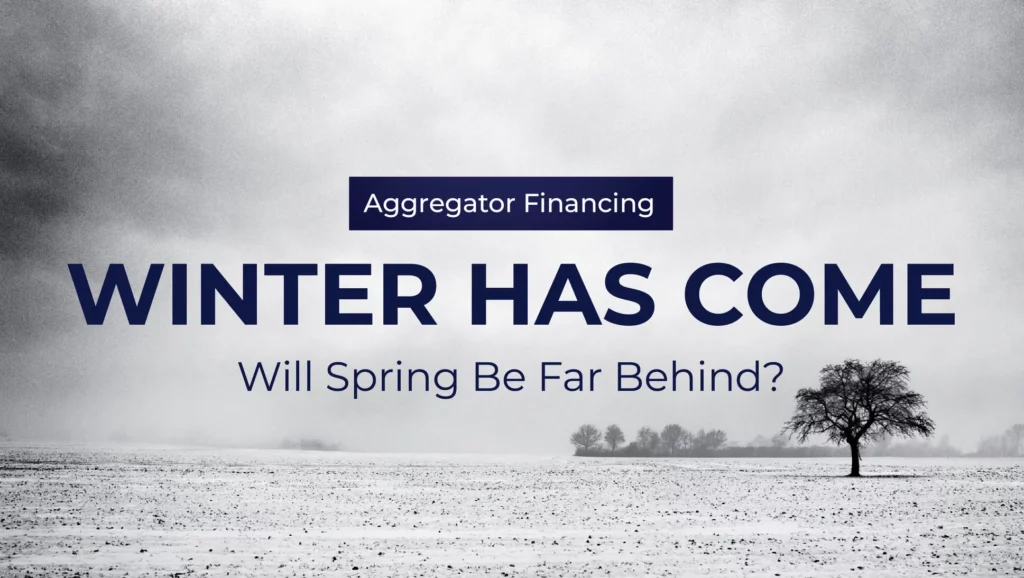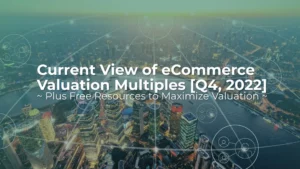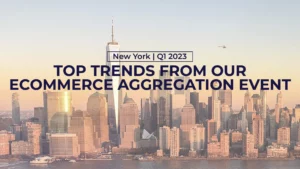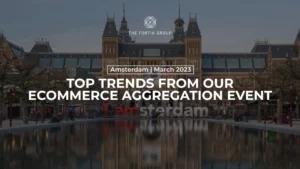Read Time: 8 minutes
Years of cheap debt followed the financial crisis (2007–2008) and M&A flourished. In 2020, the COVID pandemic restricted movement and pushed consumers online, boosting eCommerce but at the same time precipitated unprecedented sourcing and supply chain issues. Multiple geopolitical conflicts further impacted consumer demand resulting in the highest inflation in decades.
Currently, governments worldwide seek to offset inflation by increasing interest rates, with another hike recently announced by the US Federal Reserve (and another forecast for December 2022), and a similar hike by the Bank of England.
A recent report revealed that eCommerce growth is resetting to a pre-pandemic trajectory. This signals trouble for many of the aggregators that raised debt primarily based on an inflated, Covid-induced run rate.
A fundamental shift since Q1 of this year is lenders have far less appetite for risk because they do not know when the markets will bottom out and begin to recover. That said, PE firms and corporates have trillions of dollars of dry powder for acquisitions.
Valuations in public and private companies have corrected significantly, with a subsequent flight to quality. However, considering recent, high-profile setbacks, the eCommerce aggregator model is not front-of-mind for investors.
What does this all mean for financing eCommerce aggregators in the near term?
In this post, we will discuss current market conditions, and the factors that have precipitated the tough state of play for many in the eCommerce aggregator space, including the impact on valuations. Then, we’ll end by laying out the financing options for aggregators, going forward.
Inflation and Interest Rates | Quick Overview
Public market valuations have declined since Q1. Inflation is the driving force, sparked by the pandemic; fanned into flame by supply chain issues and increased demand, and conflicts like the war in Ukraine continue to add fuel to the fire.

Source: S&P 500.
In addition to supply and demand issues, the eCommerce space was hit with iOS changes (May 2021) limiting access to the customer, increased PPC costs (H2, 2021), increased marketplace fees (e.g., Amazon fuel hike Q2, 2022) – each of which negatively impacted margins, resulting in depressed valuations.
The Fed targets inflation rates at 2%. Last December’s projections for 2022 were 2.6%. However, inflation rose quickly, far exceeding initial projections and peaked this summer. The rate of inflation is forecast to end the year at mid-7%.
Subsequently, the Fed chasing the market has recently completed its fourth 75 bps interest rate hike, with the Federal Open Market Committee (FOMC) projecting it to close the year at 4.5–4.75%.
Currently, we are in the most aggressive hiking cycle in four decades. Economists recently forecast (Reuters) that this front-loading tactic should end in Q4 2022 and thereafter we’ll see a steadier rate of hikes.

Source: Federal Reserve.
Considering it can take many months for increased interest rates to positively impact inflation, it’s hard to say when rates will peak, and if this strategy has set the US on a direct collision course with a recession. The same Reuters poll put a 65% probability of a recession within one year (up from 45% in the last poll).
While spending is decreasing, consumer sentiment remains high as unemployment is low, and wages across most sectors are at the higher end of the range. Consumer behavior focused on hard goods during the pandemic has since switched to experiences. While this continues to sustain inflation rates, the labor market is shifting.
Mass layoffs across the US tech sector have dominated news cycles in October and November (2022). Considering how aggressively the tech sector hired in previous quarters, this is not the cause for alarm some might think. However, the perception and timing are bound to impact consumer sentiment. This will apply further pressure on underperforming portfolios, which will make it even more difficult for aggregators to secure financing.
The Impact for eCommerce Aggregators
While each aggregator journey is unique, in our experience, aggregator funding took the form of one part equity and typically three parts debt. So, in a $100 million raise, $75 million was delivered in tranches from lenders, and the balance in equity. The equity was generally used to build out the company, and the debt used to acquire businesses.
The covenants generally limited up-front cash multiples aggregators could pay for assets, but also ensured a standard of portfolio performance to continue acquiring.
Many aggregators priced during the COVID growth period. Fast forward to Q4 2022 with declining consumer spending, many of the same aggregators find themselves in technical default and at risk of breaching their credit facilities (if they haven’t already), as their true corporate EBITDA has not grown in ratio to the amount of outstanding debt. And depending on the amount of cash on hand and the cost of outstanding debt, it is likely that several aggregators will not be able to continue servicing their debt in 2023.
Due to the burden of debt, many aggregators have been shut out of the market, forcing them to focus on operations in 2022, and looking to use paper, or stock (in the case of Aterian), as a means of acquiring other aggregators.
Is the Market Closed for Aggregator Financing?
Credit is the driving force in the aggregator market. It is becoming increasingly scarce as interest rates continue to climb.
Our source from a US investment bank said: “We don’t have a firm view on what ‘peak’ interest rates will be, or when we will see them (if we haven’t already). We do believe that lenders’ willingness to underwrite a credit based on LTV is waning. Increasingly, lenders (including more venture-style debt providers) are focusing on corporate EBITDA-level profitability as the most important factor in determining credit quality. As such, traditional EBITDA-based leverage metrics are in focus for lenders.”
The year of operations has quickly shifted to survival as growing revenues and maintaining margins across an entire portfolio of businesses is challenging, to say the least.
Declining consumer spending and increased operating costs, coupled with the fact that many aggregators acquired assets beyond their capacity to integrate and grow, has rendered many in the space significantly over-leveraged.
The aggregators in this position have limited options, including:
- Refinancing debt – albeit the markets are effectively closed.
- Accepting equity at lower valuations (i.e., a down round) – similarly, the equity markets are closed, and existing equity investors are not willing to provide further support even for down rounds.
- Selling off assets like non-core brands as certain aggregators shift away from a category agnostic model.
- Seeking an acquirer for the firm itself – likely in a paper/stock transaction; however, such a transaction can be hard to execute where both aggregators are significantly over-levered.
Those seeking to refinance still must answer: Can they afford a higher rate of interest? This will affect what financing structure can be achieved, which narrows the available lenders considerably. “This fully depends on the size, performance, and regional exposure of the aggregator,” as one aggregator Head of M&A said. He continued “of course, if the Fed goes >5%, it will be a different ball game.”
Mergers of aggregators has been a recurring theme in our industry webinars over the last six months. Consolidation in the industry seems to be inevitable considering the large number of participants, and particularly as smaller aggregators try to find scale. Yet, this is not uncommon in a venture backed environment. Most negotiations regarding mergers of aggregators stall because firms are short on the financing needed to reduce leverage to facilitate a transaction.
We are currently buyside advisors to an aggregator who is doing >$200m in revenue with a healthy balance sheet (i.e., no term debt) and who has a path towards profitability during 2023. Contact our CEO here.
Encouraging Signs Q4, 2022 | Aggregator Financing
While the funding market is effectively closed and there is a recession on the horizon, the increase in hiring and investing in technology by some aggregators give a positive perception.
For example, industry-darling turned villain (or scapegoat), Thrasio, made headlines in 2021 with huge funding rounds, unprecedented year-on-year acquisitions, and aggressive hiring; and subsequently made headlines in 2022 by firing their entire M&A department and seeing a significant exodus at the executive level, too. However, having paused acquisitions for the best part of two quarters, we are now seeing an increase in hiring (currently Thrasio has 30 available roles, mostly in operations), and a new acquisition strategy.
Furthermore, many of the aggregators are investing in technology, building out more efficient operational infrastructures to increase capacity to integrate brands.
The impact for eCommerce M&A | Valuation Multiples
While some of the larger aggregators have paused acquisitions, there are many that are still actively acquiring. However, current market conditions have resulted in greater scrutiny around revenues, revenue growth, net margins, and brand – aggregators are being far more selective, and doing less deals. Concurrently, stricter covenants have capped valuations that can be offered to these targets.
Our recent Survey of Aggregator Valuations (July 2022) revealed that >82% of acquirers were seeing valuations in the 2X – 4X SDE/EBITDA range (including deferred consideration). This is a significant decrease in valuations from our Q4, 2021 Survey of Acquirors where >60% were offering more than 4X SDE/EBITDA on average.

Source: Olsam Group
This has further impacted deal structure (e.g., upfront vs. deferred component). Last year’s survey found 75% of the final consideration was paid upfront. As buyers seek to offset risk in the current market, equity incentives are increasingly becoming a viable option.
Join our upcoming webinar: Survey of Acquirors 2022 Insights and Outlook for eCommerce M&A
Conclusion | Aggregator Financing
The great poet, Percy B. Shelley wrote: “If Winter comes, can Spring be far behind?” History shows the markets will bounce back. Spring will come and all the dry powder on the sidelines will start to be deployed, and there will be a sharp uptick in M&A just as there was after the 2008 crash.
However, it is difficult to forecast the peak of rates – yet many in the space are watching the end of Q2 2023, with Goldman Sachs recently raising their peak fund rate forecast from 4.75 – 5% up to 5 – 5.25%.
Still, those without the capital in the short-term need options, now.
Forging the right partnerships is always crucial. For many in the eCommerce aggregator space financial partners were determined multiple funding rounds ago; it is the partnerships or mergers in the near term that could ultimately determine which aggregators navigate the coming year.
Can We Help with Your Corporate Finance Needs?
The Fortia Group is a global M&A firm for eCommerce with decades of corporate finance and eCommerce experience across $80bn worth of deals.
Schedule a call with our team to discuss:
- Selling non-core brands.
- Mergers of Aggregators (acquiring or exiting).
Sources:
New CEO of Thrasio Interview (2022)
Amazon Marketplace deals dry up
Trillions of dollars in dry powder for acquisitions
Global Interest Rates, Statista
Inflation Impacts Private Markets, LionPoint
Amazon Covid Bump, Marketplace Pulse
Post Covid eCommerce, Bloomberg







